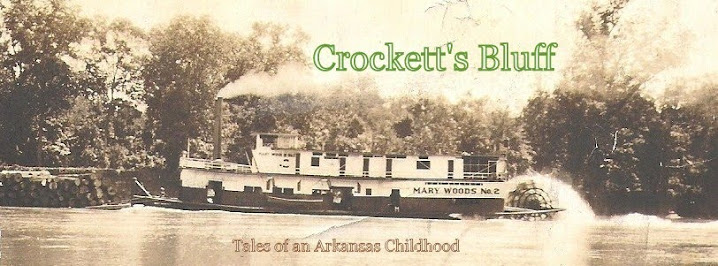 |
| Undated photograph of a family on their houseboat, presumably along the White River. Ark Post Museum State Park |
This image was posted on Facebook by Denise Parkinson who, like me, remembers houseboats up and down the White River in our younger days. I have become fascinated, largely thanks to her and a fellow Crockett's Bluff descendant Jim Prange, with the photographer Dayton Bowers who maintained a studio in DeWitt from the 1870s to his death in 1924. Clearly, one of the pioneers of the art form: more skilled (better cameras?) than Mathew Brady and with a more artistic eye. This image, like the one below of Helen Spence and her father Cicero and others, which was made by Bowers, has a number of the same details, particularly in the attention paid to its composition.
Both images have been carefully staged with captivating attention to detail. Both designed to reflect a lifestyle. Would that the houseboat gathering above had been just a bit closer to the camera. How interesting would be the details of the clothing, particularly those ties worn by men on the roof, two seating in a semi-yoga position, with another squatting to their right and two others standing behind in casual positions with a leg crossed.
Below on the lower porch, the elders? or parents? with two young girls, one standing between the elders and another perched on the railing. Everyone in his or her place. Randomly balanced.
And, unlike the image below, the houseboat leaves everything to the viewer's imagination. Is this the White River? All one family? An extended family? Since the men on the roof appear to be about the same age, were they both family and friends? Sunday afternoon? Holiday? And that relatively fancy boat tied at the right? And what's the story of the second smaller houseboat in the right background?
What is clear, however, is this dwelling is several cuts above the houseboats of the ordinary inhabitants - depicted in the image below - who made their living from the river.
Both images have been carefully staged with captivating attention to detail. Both designed to reflect a lifestyle. Would that the houseboat gathering above had been just a bit closer to the camera. How interesting would be the details of the clothing, particularly those ties worn by men on the roof, two seating in a semi-yoga position, with another squatting to their right and two others standing behind in casual positions with a leg crossed.
Below on the lower porch, the elders? or parents? with two young girls, one standing between the elders and another perched on the railing. Everyone in his or her place. Randomly balanced.
And, unlike the image below, the houseboat leaves everything to the viewer's imagination. Is this the White River? All one family? An extended family? Since the men on the roof appear to be about the same age, were they both family and friends? Sunday afternoon? Holiday? And that relatively fancy boat tied at the right? And what's the story of the second smaller houseboat in the right background?
What is clear, however, is this dwelling is several cuts above the houseboats of the ordinary inhabitants - depicted in the image below - who made their living from the river.
 |
| L-R: Cicero Spence, Helen Spence, John Black and others at fur trading barn at St. Charles. Circa 1919 |
Unlike the image above of the houseboat gathering, this image is much closer to the camera and therefore more revealing in its detail. Although intriguing in its detail of life on the White River in the early decades of the twentieth century, it is even more astonishing as a virtual glimpse of the prehistory of Cicero Spence and his daughter Helen at the left.
In her Daughter of the White River, Denise Parkinson includes an expanded view of this image that includes the unidentified figure with a rifle at the right of the black dog: "Expanded view of Cicero and Helen Spence and John Black, as well as unidentified boys and a hunter, at a fur trading barn in St. Charles, possibly circa 1918."
A staged collection of related objects, in addition to the array of furs, are displayed on the wall. Mostly "hides" of raccoons, with perhaps those of mink - far left behind the rifle next to Cicero - and a single one of a deer, with its head and antlers at Helen's left. Everyone kneeling or sitting, everyone dressed appropriately - Cicero with his pistol and vest of shells, the boys in their hats, the powder horn hanging over the deer skin - and every object significant to its theme. The Brown's Mule chewing tobacco can/box along with angled
 |
| Brown's Mule Tobacco Box |
Obviously, the photographer had more in mind than a simple recording of some folks and some furs. Hunting and trapping and fishing were the mainstays for survival on the White River in those days - especially during winter months - activities that for survival required killing and slaughter.
None of those present when this image was captured, certainly not the photographer Dayton Bowers, could have dreamed that by the time this young Helen Spence in her white leggings reached her late teens Cicero would be killed and she would use perhaps the pistol, held here casually in her father's hand, to kill "her daddy's" killer at his trial in the DeWitt Court House.
Parkinson, Denise, A Treasure Comes Home, May 2015

No comments:
Post a Comment